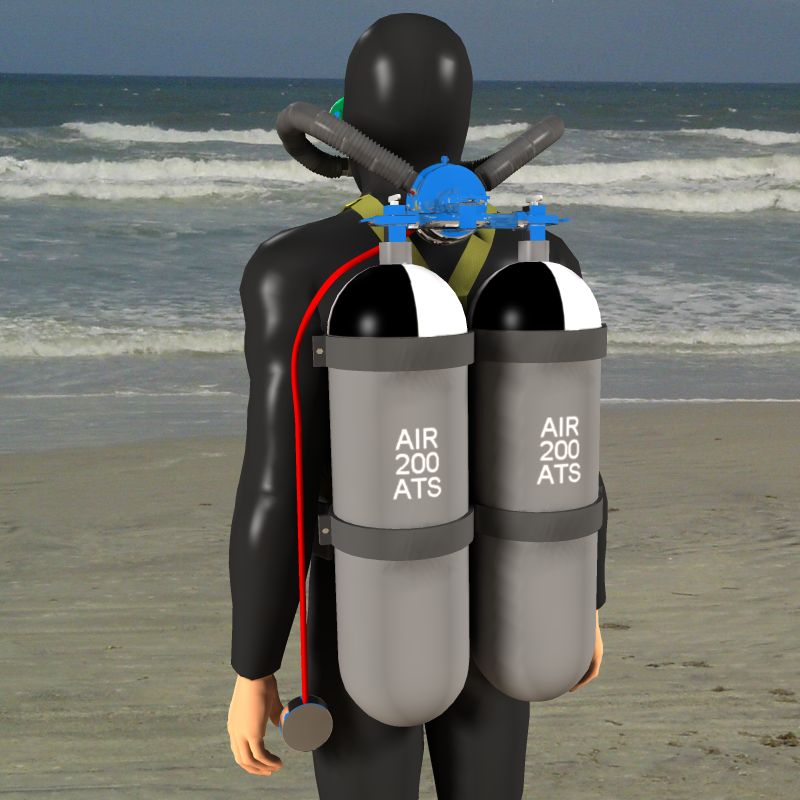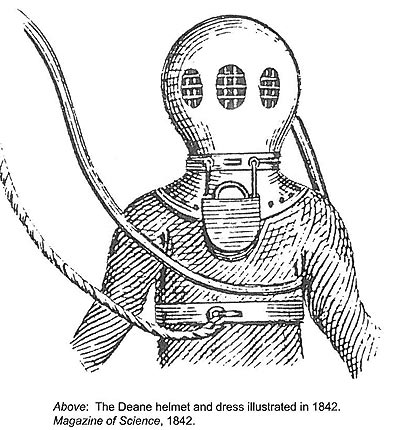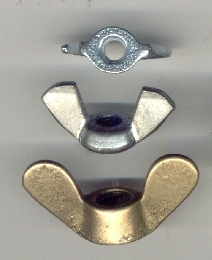|
Heinke (diving Equipment Manufacturer)
Heinke was a series of companies that made diving equipment in London, run by members of a Heinke family. Timeline *1786: Gotthilf Frederick Heinke was born in Messeritz, Prussia.: He arrived in London in 1809 and worked initially as a victualler to build up capital *1812: He married Sarah Smith, who bore him three sons and two daughters. *1816: John William Heinke (son of Gotthilf Frederick) born. *1818: Gotthilf Frederick Heinke opened an ironmongery shop business in London. *1818: Charles Edwin Heinke (son of Gotthilf Frederick) born. *1819: Gotthilf Frederick Heinke got a workshop at 103 Great Portland Street in London since 1819. *1820: Gotthilf Henry Heinke (son of Gotthilf Frederick) born. *1839: Gotthilf Frederick Heinke opened a second premises at 3 Old Jewry, London. *1840: John William Heinke married Louisa Margaret Leathart. Start of making diving helmets *1844: Around then Charles Edwin Heinke made his first diving helmet. Inspired by William F. Saddler, Heinke ... [...More Info...] [...Related Items...] OR: [Wikipedia] [Google] [Baidu] |
Diving Equipment
Diving equipment is equipment used by underwater divers to make diving activities possible, easier, safer and/or more comfortable. This may be equipment primarily intended for this purpose, or equipment intended for other purposes which is found to be suitable for diving use. The fundamental item of diving equipment used by divers other than freedivers, is underwater breathing apparatus, such as scuba equipment, and surface-supplied diving equipment, but there are other important items of equipment that make diving safer, more convenient or more efficient. Diving equipment used by recreational scuba divers, also known as scuba gear, is mostly personal equipment carried by the diver, but professional divers, particularly when operating in the surface supplied or saturation mode, use a large amount of support equipment not carried by the diver. Equipment which is used for underwater work or other activities which is not directly related to the activity of diving, or which has n ... [...More Info...] [...Related Items...] OR: [Wikipedia] [Google] [Baidu] |
Old Jewry
Old Jewry is a one-way street in the City of London, the historic and financial centre of London. It is located within Coleman Street ward and links Poultry to Gresham Street. The street now contains mainly offices for financial companies. The nearest London Underground station is Bank and the closest mainline railway station is Cannon Street. Early history Soon after the Norman Conquest, William the Conqueror encouraged Jews to come to England. Some settled in cities throughout his new domain, including in London. According to Reverend Moses Margoliouth, Old Jewry was a ghetto. Ghettos, areas of a city mainly or exclusively populated by Jews, were common across Europe. In 2001, archaeologists discovered a mikveh (ritual bath) near to Old Jewry, on the corner of Gresham Street and Milk Street, under what is now the State Bank of India. It would have fallen into disuse after 1290, when the Jews were expelled from England. On the west side of Old Jewry is St Olave Old Jewry ... [...More Info...] [...Related Items...] OR: [Wikipedia] [Google] [Baidu] |
Snorkel (swimming)
A snorkel is a device used for breathing air from above the surface when the wearer's head is face downwards in the water with the mouth and the nose submerged. It may be either separate or integrated into a swimming or diving mask. The integrated version is only suitable for surface snorkeling, while the separate device may also be used for underwater activities such as spearfishing, freediving, finswimming, underwater hockey, underwater rugby and for surface breathing with scuba equipment. A swimmer's snorkel is a tube bent into a shape often resembling the letter "L" or "J", fitted with a mouthpiece at the lower end and constructed of light metal, rubber or plastic. The snorkel may come with a rubber loop or a plastic clip enabling the snorkel to be attached to the outside of the head strap of the diving mask. Although the snorkel may also be secured by tucking the tube between the mask-strap and the head, this alternative strategy can lead to physical discomfort, mask leakage ... [...More Info...] [...Related Items...] OR: [Wikipedia] [Google] [Baidu] |
Swimfin
Swimfins, swim fins, diving fins, or flippers are finlike accessories worn on the feet, legs or hands and made from rubber, plastic, carbon fiber or combinations of these materials, to aid movement through the water in water sports activities such as swimming, bodyboarding, bodysurfing, float-tube fishing, kneeboarding, riverboarding, scuba diving, snorkeling, spearfishing, underwater hockey, underwater rugby and various other types of underwater diving. Swimfins help the wearer to move through water more efficiently, as human feet are too small and inappropriately shaped to provide much thrust, especially when the wearer is carrying equipment that increases hydrodynamic drag. Very long fins and monofins used by freedivers as a means of underwater propulsion do not require high-frequency leg movement. This improves efficiency and helps to minimize oxygen consumption. Short, stiff-bladed fins are effective for short bursts of acceleration and maneuvering, and are useful for bod ... [...More Info...] [...Related Items...] OR: [Wikipedia] [Google] [Baidu] |
Aqua-lung
Aqua-Lung was the first open-circuit, self-contained underwater breathing apparatus (or "scuba") to achieve worldwide popularity and commercial success. This class of equipment is now commonly referred to as a twin-hose diving regulator, or demand valve. The Aqua-Lung was invented in France during the winter of 1942–1943 by two Frenchmen: the engineer Émile Gagnan and the Naval Lieutenant (French: "lieutenant de vaisseau") Jacques Cousteau. It allowed Cousteau and Gagnan to film and explore underwater more easily. The invention revolutionised autonomous underwater diving by providing a compact, reliable system capable of a greater depth range and endurance than its precursors, and was a major factor influencing the development of recreational scuba diving after WWII. The twin-hose Aqua-Lung demand regulator is the foundation of all modern scuba regulators. A diaphragm is used to control a valve to deliver the breathing gas to the diver on demand, at ambient water pressure. Ho ... [...More Info...] [...Related Items...] OR: [Wikipedia] [Google] [Baidu] |
Standard Diving
Standard diving dress, also known as hard-hat or copper hat equipment, deep sea diving suit or heavy gear, is a type of diving suit that was formerly used for all relatively deep underwater work that required more than breath-hold duration, which included marine salvage, civil engineering, pearl shell diving and other commercial diving work, and similar naval diving applications. Standard diving dress has largely been superseded by lighter and more comfortable equipment. Standard diving dress consists of a diving helmet made from copper and brass or bronze, clamped over a watertight gasket to a waterproofed canvas suit, an air hose from a surface-supplied manually operated pump or low pressure breathing air compressor, a diving knife, and weights to counteract buoyancy, generally on the chest, back and shoes. Later models were equipped with a diver's telephone for voice communications with the surface. The term ''deep sea diving'' was used to distinguish diving with this equipme ... [...More Info...] [...Related Items...] OR: [Wikipedia] [Google] [Baidu] |
Wingnut (hardware)
A wingnut, wing nut or butterfly nut is a type of nut with two large metal "wings", one on each side, so it can be easily tightened and loosened by hand without tools. A similar fastener with a male thread is known as a wing screw or a wing bolt. Types ASME B18.6.9 classifies wing nuts first by manufacturing method and then by style. * Type A are cold forged or cold formed produced in regular, light and heavy dimensional series. * Type B are hot forged solid nuts available in three different wing styles. * Type C are die cast nuts available in three wing styles with variances between regular and heavy dimensional series * Type D are stamped sheet metal nuts available in three wing styles. Usage Bicycles Before the development of quick release skewers, bicycle wheels were held in place with wingnuts. Drum hardware In a drum kit wingnuts and wingbolts are used extensively. * For securing a suspended cymbal on the mounting bolt of a cymbal stand. * For securing an adjustment on a ... [...More Info...] [...Related Items...] OR: [Wikipedia] [Google] [Baidu] |
Institution Of Civil Engineers
The Institution of Civil Engineers (ICE) is an independent professional association for civil engineers and a charitable body in the United Kingdom. Based in London, ICE has over 92,000 members, of whom three-quarters are located in the UK, while the rest are located in more than 150 other countries. The ICE aims to support the civil engineering profession by offering professional qualification, promoting education, maintaining professional ethics, and liaising with industry, academia and government. Under its commercial arm, it delivers training, recruitment, publishing and contract services. As a professional body, ICE aims to support and promote professional learning (both to students and existing practitioners), managing professional ethics and safeguarding the status of engineers, and representing the interests of the profession in dealings with government, etc. It sets standards for membership of the body; works with industry and academia to progress engineering standards a ... [...More Info...] [...Related Items...] OR: [Wikipedia] [Google] [Baidu] |
Congestion Of The Liver
Congestive hepatopathy, is liver dysfunction due to venous congestion, usually due to congestive heart failure. The gross pathological appearance of a liver affected by chronic passive congestion is "speckled" like a grated nutmeg kernel; the dark spots represent the dilated and congested hepatic venules and small hepatic veins. The paler areas are unaffected surrounding liver tissue. When severe and longstanding, hepatic congestion can lead to fibrosis; if congestion is due to right heart failure, it is called cardiac cirrhosis. Signs and symptoms Signs and symptoms depend largely upon the primary lesions giving rise to the condition. In addition to the heart or lung symptoms, there will be a sense of fullness and tenderness in the right hypochondriac region. Gastrointestinal catarrh is usually present, and vomiting of blood may occur. There is usually more or less jaundice. Owing to portal obstruction, ascites occurs, followed later by generalised oedema. The stools are light ... [...More Info...] [...Related Items...] OR: [Wikipedia] [Google] [Baidu] |
Bermondsey
Bermondsey () is a district in southeast London, part of the London Borough of Southwark, England, southeast of Charing Cross. To the west of Bermondsey lies Southwark, to the east Rotherhithe and Deptford, to the south Walworth and Peckham, and to the north is Wapping across the River Thames. It lies within the historic county boundaries of Surrey. History Toponymy Bermondsey may be understood to mean ''Beornmund''s island; but, while ''Beornmund'' represents an Old English personal name, identifying an individual once associated with the place, the element "-ey" represents Old English ''eg'', for "island", "piece of firm land in a fen", or simply a "place by a stream or river". Thus Bermondsey need not have been an island as such in the Anglo-Saxon period, and is as likely to have been a higher, drier spot in an otherwise marshy area. Though Bermondsey's earliest written appearance is in the Domesday Book of 1086, it also appears in a source which, though surviving only in ... [...More Info...] [...Related Items...] OR: [Wikipedia] [Google] [Baidu] |
Diving Dress
Standard diving dress, also known as hard-hat or copper hat equipment, deep sea diving suit or heavy gear, is a type of diving suit that was formerly used for all relatively deep underwater work that required more than breath-hold duration, which included marine salvage, civil engineering, pearl shell diving and other commercial diving work, and similar naval diving applications. Standard diving dress has largely been superseded by lighter and more comfortable equipment. Standard diving dress consists of a diving helmet made from copper and brass or bronze, clamped over a watertight gasket to a waterproofed canvas suit, an air hose from a surface-supplied manually operated pump or low pressure breathing air compressor, a diving knife, and weights to counteract buoyancy, generally on the chest, back and shoes. Later models were equipped with a diver's telephone for voice communications with the surface. The term ''deep sea diving'' was used to distinguish diving with this equipme ... [...More Info...] [...Related Items...] OR: [Wikipedia] [Google] [Baidu] |
Morse Diving
Morse Diving was an American manufacturer of diving equipment Diving equipment is equipment used by underwater divers to make diving activities possible, easier, safer and/or more comfortable. This may be equipment primarily intended for this purpose, or equipment intended for other purposes which is found ... founded in 1837. Morse filed for bankruptcy and Diving Equipment and Supply Company (DESCO) acquired its assets in 2016. DESCO also continues to use their original DESCO equipment to produce Mark V helmets under their name as well. Company History In 1837, Fletcher & Morse Co. opened at the corner of Water and Congress Streets in Boston MA. The company began as a manufacturer of brass goods for the marine industry. A few years later Mr. Fletcher retired from the firm. In 1864, the company's name was changed to Andrew J. Morse & Son. When the company began making diving helmets is not clear. The earliest company records are for compressor pumps which date back to the Civi ... [...More Info...] [...Related Items...] OR: [Wikipedia] [Google] [Baidu] |

_1.427_-_Sir_R._Clayton's_House%2C_Garden_Front.jpg)






